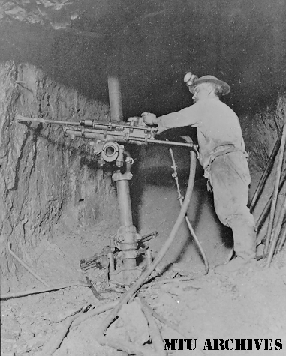It cannot be said that
the one-man drill was a "bad" invention. It most certainly did the
job it was designed for. And did it well. Nevertheless, the
introduction of this technological innovation had very severe social implications
for the copper mining industry.
Miners hated the
idea of it. When the strike began in 1913, the one-man drill was
one of the primary causes of outrage. There were several reasons for
their hatred of it. First and foremost of their concerns, was the elimination of the
"buddy system." Under the two-man drill system, it took two men (obviously)
to run a single machine. This meant that if something went wrong (i.e.
a cave-in, lights going out, etc.) then there would be someone there to help
get them out. It also meant they simply had someone to chat with during
the long hours underground. They were a team. With the one-man
drill came nothing but isolation. It only took one man to do the same
task, so that one man would be by himself when something went wrong. That
one man would have no one to talk to during the long 10-12 hour work days.
It became a dangerous and lonely job.
The miners were also
concerned that if it only took half the work force to do the same amount
of drilling then they were in danger of losing their jobs. Potentially
50% of the miners drilling could have been laid off without lessening the
amount of copper produced.
There were many other
reasons unrelated to the drill that the miners went on strike. The
mining companies refused to budge, referring to the union as a group
of "bullies" and "Communists." On the next few pages is a demonstration
of the effects of the drill from the mining companies' perspective.
It ignores the concerns and complaints of the workers and instead focuses
on the raw numbers and how much the drill improved efficiency. It compares
a set of accounting cost sheets from Quincy Mine during the month of July in 1910
and 1915. This is intended to give a "before and after" look at the industry with
respect to the drill.
